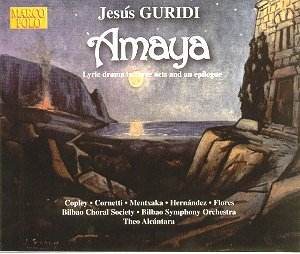
|
Jesús GURIDI
(1888-1961) Amaya - Lyric drama in 3 acts and an epilogue (1920) based on the novel Amaya by Navarro Miloslada libretto by Fr José de Arrúe Amagoya - Marianne Cornetti (mz) Paula eta Olalla - Itxaro Mentxaka (mz) Teodosio - César Hernández (ten) Asier - Rosendo Flores (bass) other roles - Carlos Conde (bar), Angel Pazos (ten), Gorka Robles (ten). Bilbao Choral Society/Gorka Sierra Bilbao SO/Theo Alcántara rec Teatro Arriaga, Bilbao, 17-20 June 1998 DDD |
This is lyric and dramatic grand opera of the most luxurious stamp but cut through with impressionistic techniques. While Guridi did write in the zarzuela tradition Amaya is completely free of that lighter bloodline. The opera proclaims not only its Basque nationality (it is sung in Basque on a Basque subject) but also its melodic brilliance stylistically allied to people like Ropartz, Lazzari and Aubert. A decade or so later and another apt parallel is to be found in Howard Hanson's opera Merry Mount. It has much the same heart-set.
Plot: Teodosio and Asier (representing Pagan and new Christian traditions) vie for the love of Amaya against the backdrop of tensions and conflict between the two traditions. Teodosio, always untrusting of Amaya and ready to believe a mysterious hermit, returns home to avenge himself on his supposedly faithless wife, Amaya. Rushing into the darkened bedchamber he kills the couple lying there only to meet Amaya as he leaves with dripping sword. Amaya explains how she let Teodosio's parents use their bedchamber while he was away at war. Teodosio is mortified and takes to the wilderness as a hermit. Later the dying Asier returns and admits that he was the hermit who misled Teodosio into returning vengefully home. Teodosio at last can forgive himself and is reunited with Amaya.
The 'look and feel' of this music is in the same yard as George Lloyd's much much later John Socman, Puccini's Tosca and Turandot and Saint-Saëns' Samson and Delilah. The score is encrusted with treasurable highlights including Hail, Oh Moon (CD1 track 4 15.02) for Cornetti and the chorus. Guridi learnt much from study of the scores of Rimsky-Korsakov (Antar) and his brilliance of orchestration is apparent as also is his love for the music of the rocks, the sea and the people of the North Iberian Atlantic coasts. The Wedding Hymn music (CD1 at start of track 6) reveals how Russian influences reached far and wide and reminded me of the Belgian luminary Adolphe Biarent. Biarent, too, learnt much from Rimsky.
The work demonstrates the most mellifluous of bel canto avoiding the soporific and the fatuous. High romance flares in the love duet between Amaya and Teodosio in scene 3 of Act 2. The orchestra is alert in general and though the Bilbao strings are not a thing of sable and roses they are vivid enough. Only in the Espatadanza towards the end of Act 2 did I think that the conductor could have stiffened his sinews and honed the reflexes. In scene 2 Act III the duet between Teodosio and the hermit (Asier in disguise) recalls the baritone writing in Sibelius's Kullervo symphony. The overall effect of the opera is marred only slightly by the sanctimonious tone of the closing scene.
I was not at all surprised to read that Copley has sung Turandot for she has that expansive and dramatic character of voice. The slight pity is that she is given to a squalliness of tone when she has to sing under pressure - and this is a grand grand opera. I note that both Copley and Cornetti were born in the USA. Interesting that an opera sung in Basque should draw down talent from outside the Basque lands.
Helpful notes and synopsis (in English, German and French) by Santiago Gorostiza and a Basque-English parallel translation for the libretto. This is very well keyed into tracks and times. One niggle was that the printing on some pages had faded to grey and might be difficult for some eyes.
Now, please, Marco Polo, having achieved highly with this Amaya move onwards to Lazzari's La Lépreuse, Ropartz's Le Pays and Canteloube's Le Mas. So far as Guridi is concerned many of us are waiting with bated breath for the first recording of his Sinfonia Pirenaica but it would be a delight also to have the opera Mirentxu (1915).
Puccini or Korngold fans should not delay neither should anyone partial to grand romantic opera with a stroke or ten of the exotic.
The recording is excellent - courtesy of Andrew Keener.
Rob Barnett
See also reviews by Terry Barfoot and Christopher Webber (the latter with complete discography)